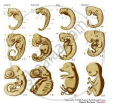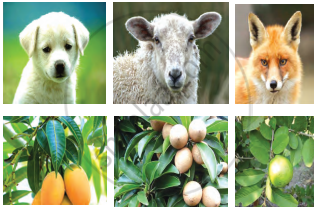Advertisements
Advertisements
Question
Observe the picture and answer the following questions.
A) Which evidence of evolution is shown in the picture?
B) What can be proven with this proof?
C) Give one more example of evidence of evolution
Solution
A) Embryological evidence of evolution has been shown in the picture.
B) Similarities between all embryos in early stages indicates that all those animals may have common ancestor.
C) Vestigial organs, Connecting link, etc.
APPEARS IN
RELATED QUESTIONS
What are vestigial organs?
Give two examples of vestigial organs in human beings and plants.
(a) Select the analogous structures from the combination given below:
(i) Forelimbs of whales and bats
(ii) Eyes of octopus and mammals
(iii) Tuber of sweet potato and potato
(iv) Tuber of Bougainvillea and tendrils of Cucurbita
(b) State the kind of evolution they represent
Study the following statements:-
I. Wings of birds and wings of bats are homologous organs.
II. Wings of birds and wings of insects are modified forelimbs.
III. Wings of birds and wings of insects are analogous organs.
IV. Wings of birds and forelimbs of horse are homologous organs.
The correct statements are
(A) I and II
(B) II and III
(C) III and IV
(D) I and IV
Which one of the following pairs of vegetables is an example of homologous structures?
(A) Potato and sweet potato
(B) Carrot and radish
(C) Carrot and tomato
(D) Tomato and radish
Explain the terms analogous and homologous organs with examples.
Enlist any four sequential evolutionary names of human ancestors.
Explain with an example for the given, how the following provides evidence in favor of evolution in organisms :
Fossils
Human tailbone is a vestigial organ. Explain.
The organs which perform different functions but have the same basic structure are known as :
(a) homologous organs
(b) analogous organs
(c) homolytic organs
(d) analytic organs
Vestigial organ ______ present in human body is proof of evolution.
_______ is a connecting link between Annelida and Arthropoda.
With the help of diagrams, describe emasculation and bagging.
Draw a labelled diagram of T.S. of a leaf showing Kranz anatomy.
Choose the correct option of the following question:
Wings of Insect and Birds are examples of :
Explain any three molecular (genetic) evidences in favour of organic evolution.
Very short answer question.
What are homologous organs?
Explain the importance of Anatomical evidences with examples.
Find an odd one out.
Give scientific reason.
Peripatus is said to be the connecting link between Annelida and Arthropoda.
What is carbon dating?
Observe the given images and answer the following questions.

- Which evolutionary evidence does it indicate?
- What does it prove?
- State another example of evolutionary evidence.
Which evidence of evolution is shown in the given picture? Explain the importance of this evidence.

Observe the following images and answer the questions.

- Which evolutionary evidences are indicated in the given picture?
- How are they formed?
- Which method is used to measure their age or their time?
Select the correct statement.
Evolution has exhibited a greater stability of molecular structure when compared with morphological structures. Comment on the statement and justify your opinion.
Cucurbits do not develop thick and woody stem as they are:
Palaeontological evidence for evolution refers to the ______.
Which of the following is used as an atmospheric pollution indicator?
Animal husbandry and plant breeding programmes are the examples of ______.
The bones of forelimbs of whale, bat, cheetah and man are similar in structure, because ______.
Fossils are generally found in ______.
What were the characteristics of life forms that had been fossilised?
What are we referring to? When we say 'simple organisms' or 'complex organisms'.
How do we compute the age of a living tree?
I am the connecting link of annelida and arthropoda. What is my name?
What is the function of the appendix of our digestive system?
As shown in figure below some organisms that share a common ancestor have features that have different functions, but similar structures.

These are known as ______. Give example.
Find the odd one out:
Explain natural selection with the example of industrial melanism.
